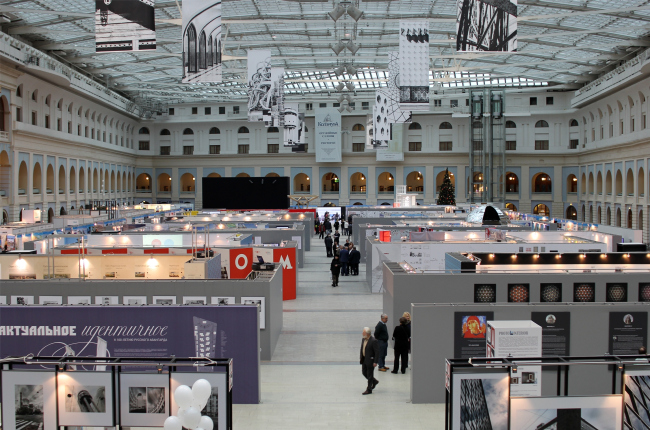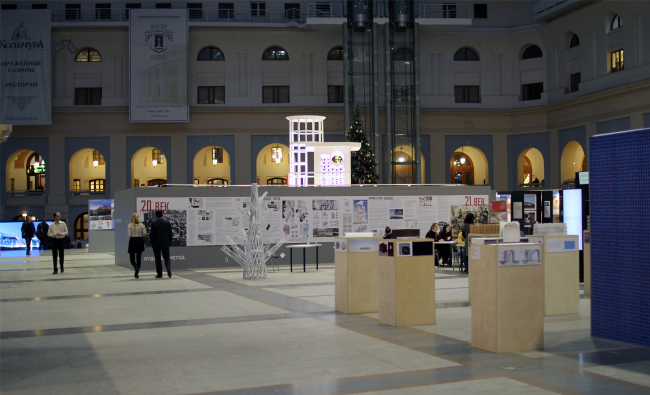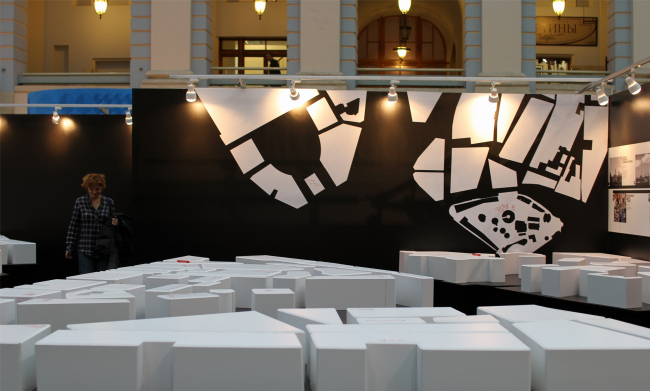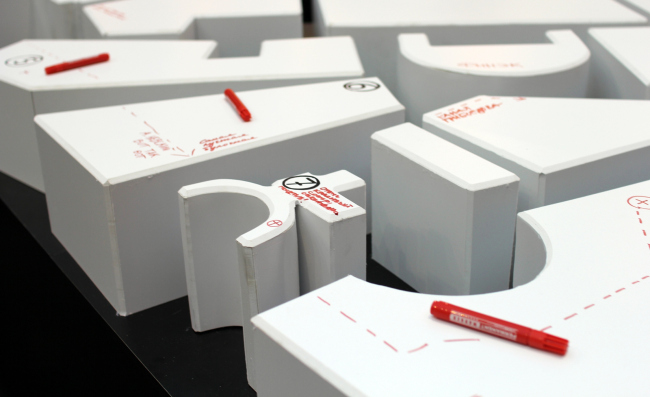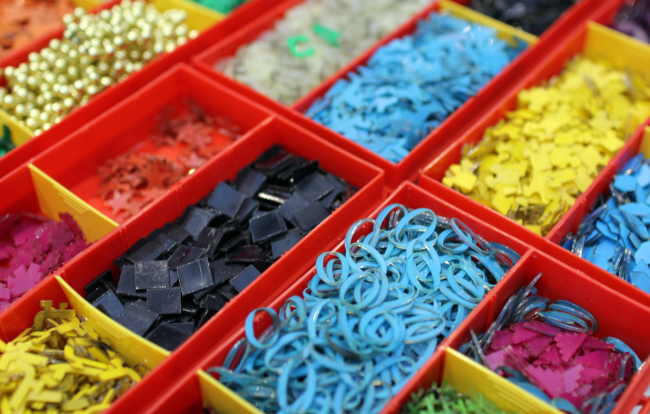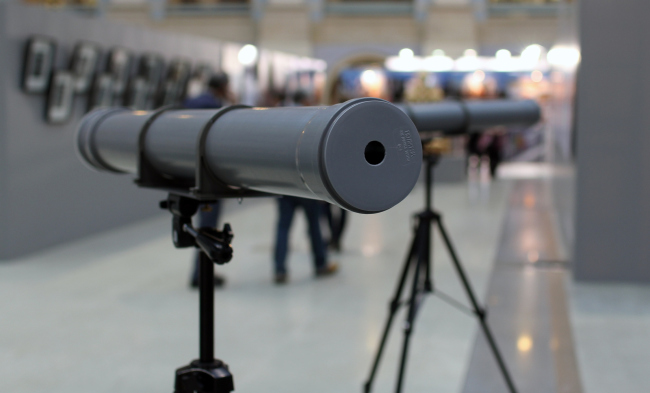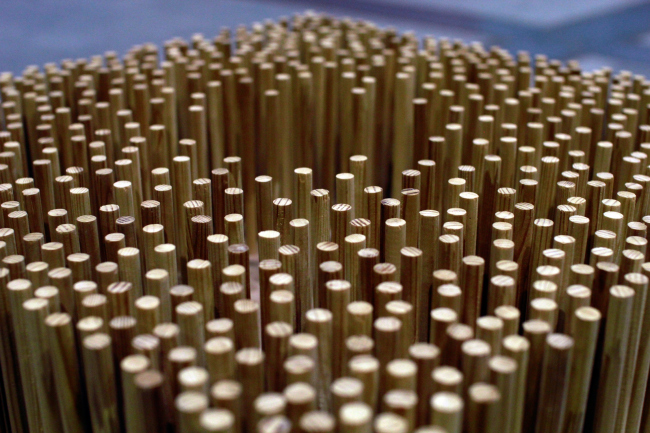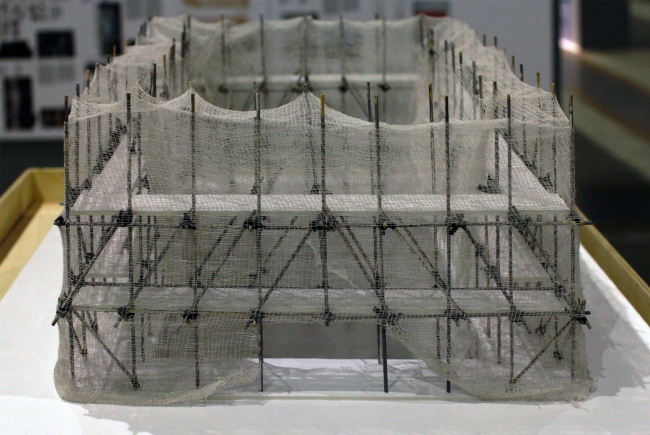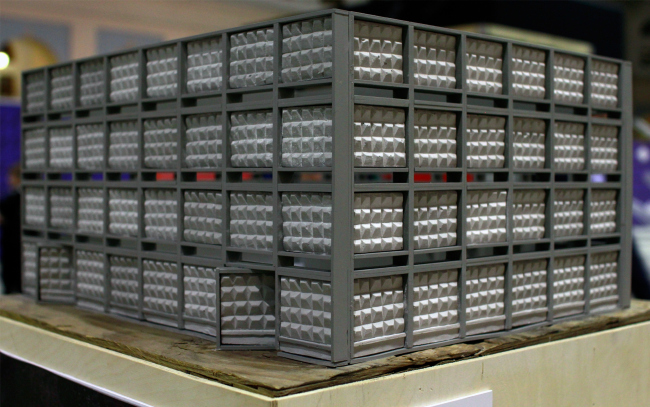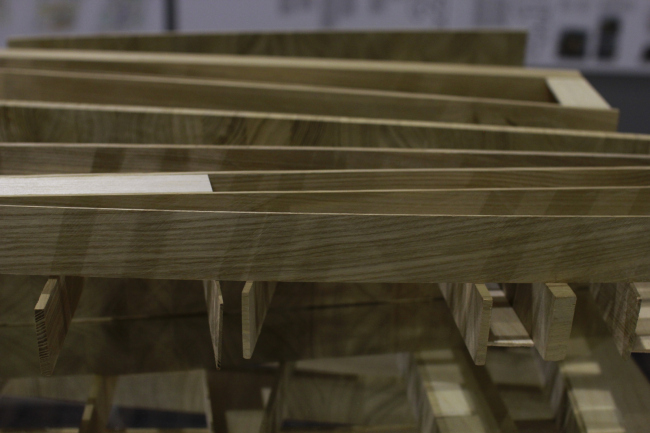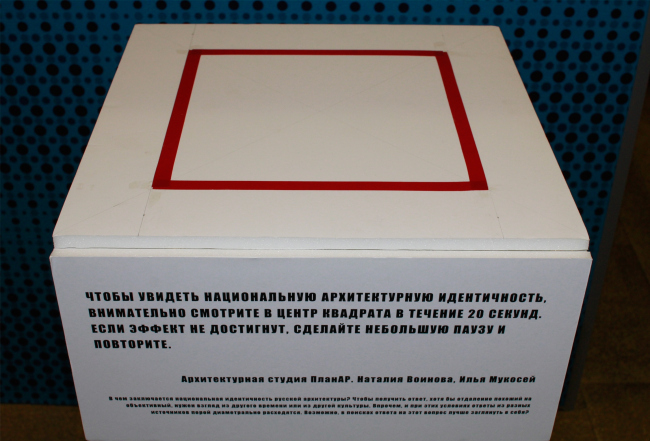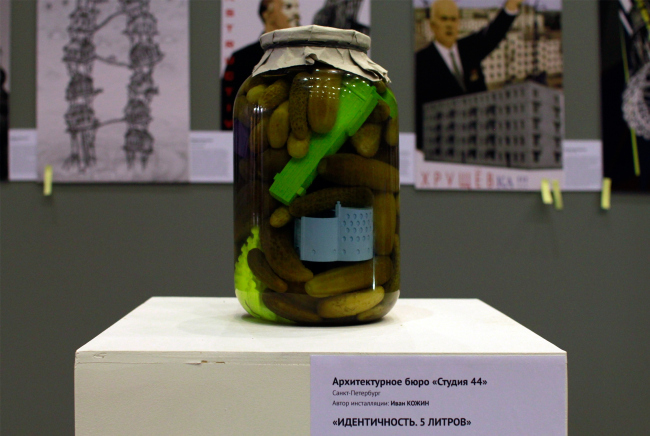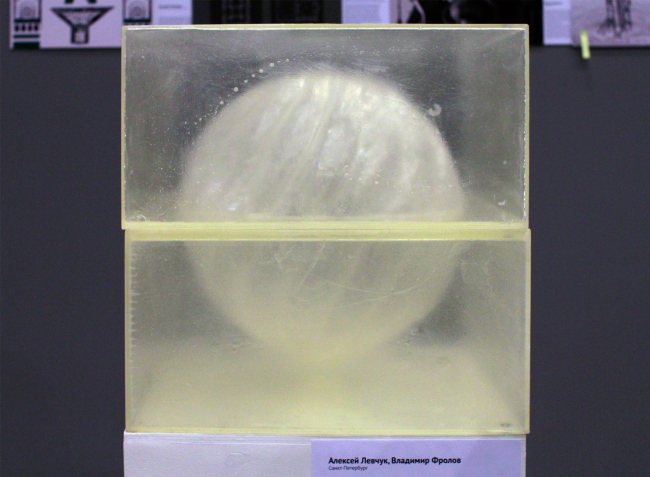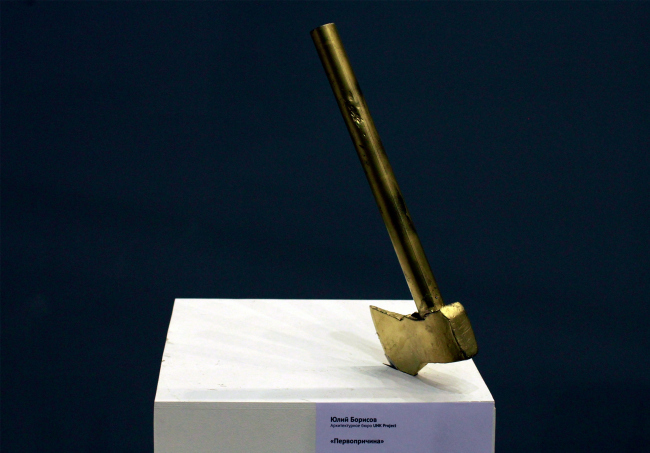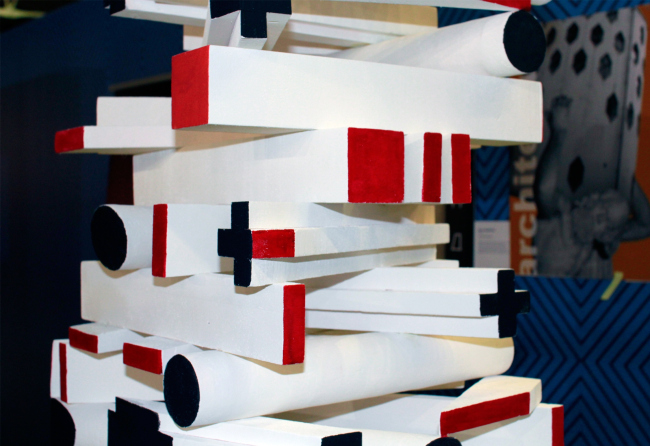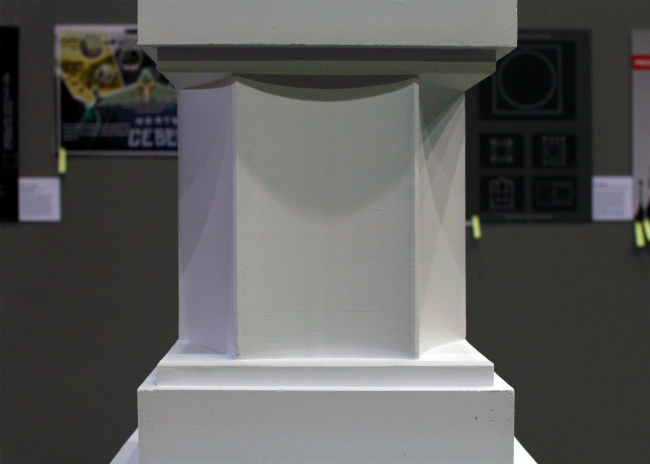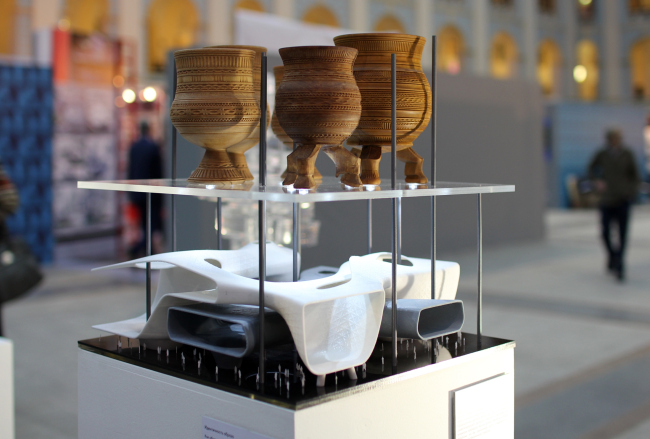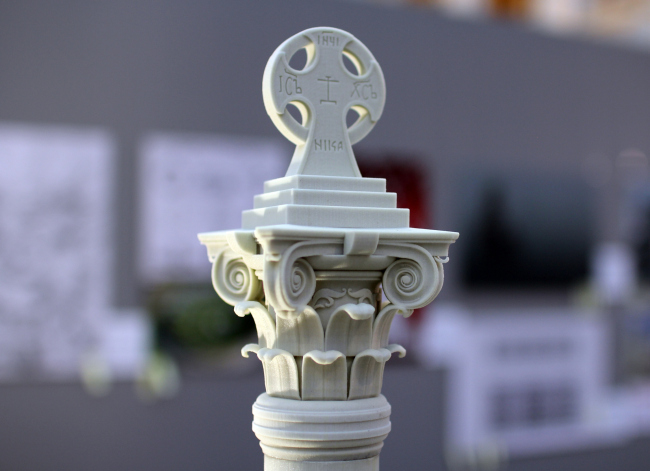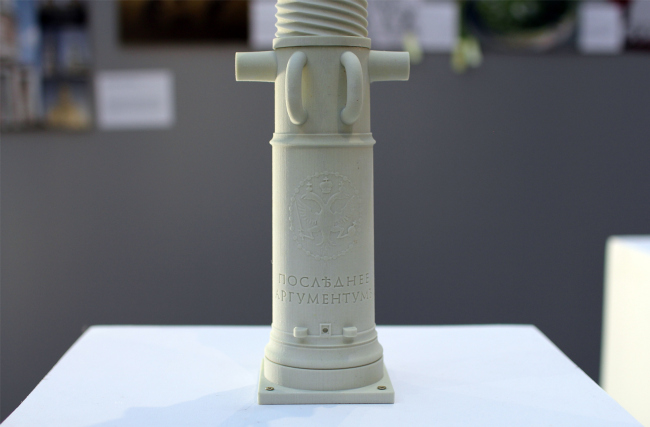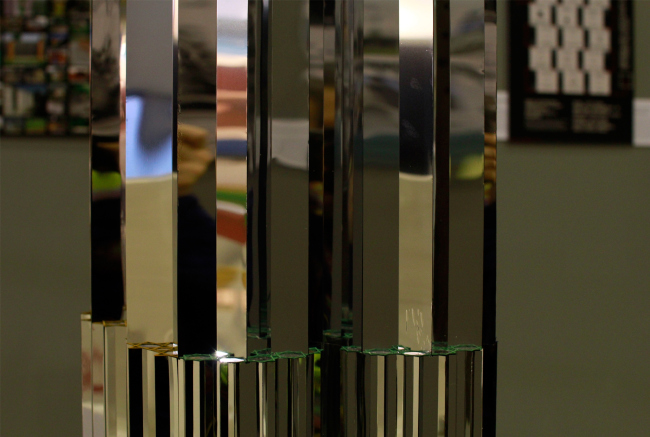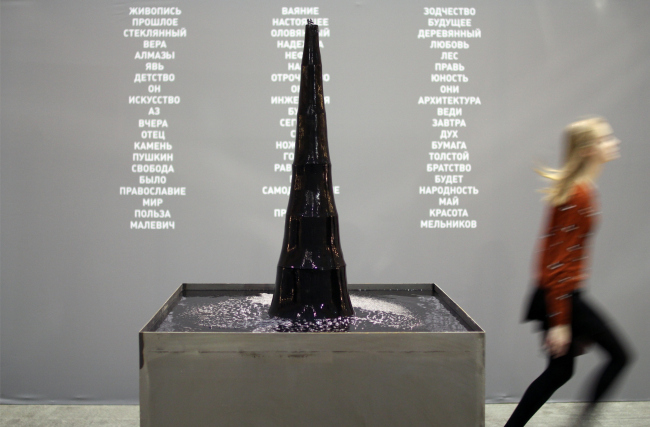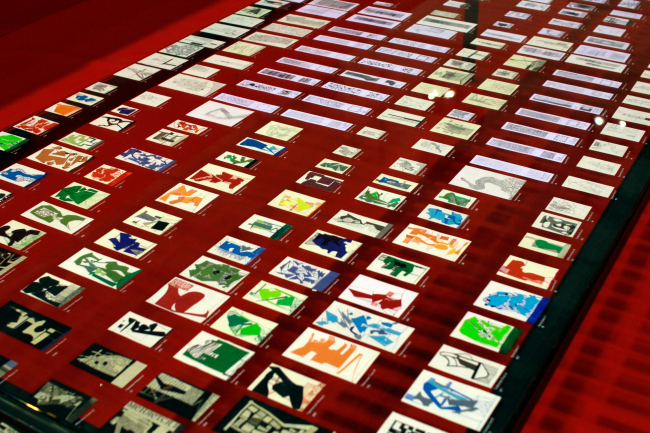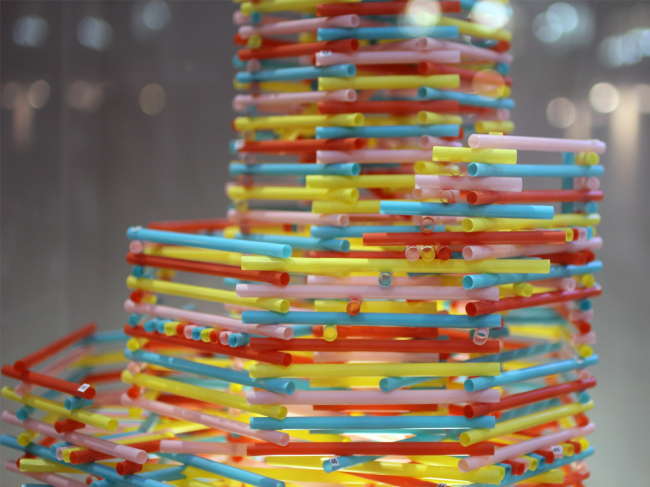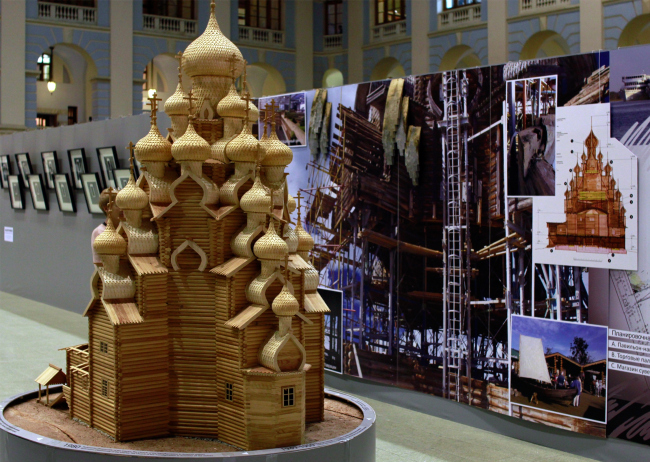|
Published on Archi.ru (https://archi.ru) |
|
| 19.12.2014 | |
|
Mysteries of the Russian Soul |
|
|
Julia Tarabarina |
|
|
The participants of "Zodchestvo" Festival were able to shift its precarious theme of "national identity" into the only possible sane area: nervous self-analysis bordering on the grotesque. With a moveless countenance.
"Zodchestvo" 2014. Photo © Julia Tarabarina, Archi.ru‘Would you tell me, please, which way I ought to go from here?’
‘That depends a good deal on where you want to get to,’ said the Cat. ‘I don’t much care where - ’ said Alice. ‘Then it doesn’t matter which way you go,’ said the Cat. ‘ - so long as I get somewhere,’ Alice added as an explanation. ‘Oh, you’re sure to do that,’ said the Cat, ‘if you only walk long enough.’ Lewis Carroll, Alice’s Adventures in Wonderland Recently, the exhibition center Gostiny Dvor played host to "Zodchestvo" Festival - for a few years already, this festival goes on not for four but for three days, so one should waste no time if he or she wants to see much of it. The festival was opened by minister Medinsky, at the entrance you see smiling portraits of Lenin and Putin, Khrushchev is brandishing his proverbial shoe, then you bump into "Crimea-is-ours" and other inevitable signs of your national identity. In a word, I was pretty scared to go there, although I did a fair bit of homework: during the entire autumn we kept interviewing the curators of the special projects about their creative plans. As for the visitor turnout, it is actually poor; somebody has already said the festival is "half-empty". The visitor flow grows weaker by the year in spite of the free entrance. And this sure is a pity. Because this time around the curators, Asadov brothers, despite their, well, unconventional ideas of avant-garde, as well as identity, were able to organize the expo space really well - which is rarely the case with "Zodchestvo". Glowing in the distance: the stand is dedicated to the architect Boris Belozersky. "Zodchestvo" 2014. Photo © Julia Tarabarina, Archi.ruThis year, the exhibition space is a hybrid of the cells that were a few years ago proposed by Yuri Avvakumov in an attempt to turn "Zodchestvo" into a biennale - and a maze of booths that the festival has always consisted of. Gostiny Dvor is filled with square exhibition booths, lined up in a Basilica fashion along the broad main nave, crossed by a just as broad transept. On the outside, the walls are mostly light-gray; in the corridors, on these walls there are expositions of the curator program, inside - projects by regions and agencies, although closer to the end of the exposition this logic seems to fade. Still - a lot of light, a lot of space to breathe, and neither plastic expositions nor the kitsch spots are too noticeable. The lightness of the atmosphere is successfully supported by the two main stands - that of Moscow and that of Saint Petersburg: we all remember the carpets, the glowing floors and other striking and expensive whistles and bells; today, however, the Moscow stand, dedicated to the riverfront development of the Moskva River, is finished with plywood and is decorated by the model of the river that Scientific-Research and Design Institute of the General Plan of Moscow already showcased at "Zodchestvo" last year. The stand of Saint Petersburg's Committee for City Planning and Architecture must be recognized as the best of all the regional ones: it features a very general and unpretentious but still rather large waist-high model of the city center. Wandering among the laconic cabinets of the model buildings, the visitor can actually write on them with a red marker his or her thoughts and insights about different places; a few words and phrases are already written - probably, to help the visitor to easier find his or her bearings - while there is actually a promise that the information and ideas collected on such a way will be forwarded directly to Saint Petersburg's Committee for City Planning and Architecture. The interactive idea is far from effective - but the amusement is well worth it. Stand of Committee for City Planning and Architecture of Saint Petersburg. "Zodchestvo" 2014. Photo © Julia Tarabarina, Archi.ruStand of Committee for City Planning and Architecture of Saint Petersburg. "Zodchestvo" 2014. Photo © Julia Tarabarina, Archi.ruThe curators promised that there would be more thematic exhibitions than ever before, and they stood by their word. Half of them, though, turned out to be just pads handing on the walls - but the other half was truly grand-scale. Let us begin with the main subject of the festival, though. It was chosen on a joint basis but, as is often the case, the organizers were unable to arrive at a single decision, and it turned out that "Zodchestvo" is dedicated simultaneously to at least two things: the hundredth anniversary of avant-garde and the search for identity of the Russian architecture. The two festival themes, avant-garde and national identity, coexist in the central space of the exhibition, parallel to each other and in two totally different ways. Everything that has to do with the avant-garde and Art-Nouveau is more like a catalogue or a visitor's guidebook, and palpably refers to the process of enlightening the general public on the subject of the history of this architectural trend that happens to celebrate an anniversary now. Fragments of the catalogue are diluted by a number of sturdy black kiosks, each one representing an object of the postwar Art-Nouveau, and by an Edward Kubensky performance project where the visitors are entertained with kaleidoscopes from the icons of "black square", "Mayakovsky T-shirt", "Melnikov's windows" and many others: each visitor can put together a kaleidoscope of his own and then buy it as a souvenir. Project of Edward Kubensky "Patterns of the Russian Avant-garde. The kaleidoscopes can be put together from a set of color plaques that the visitors can buy on the spot. "Black Square", "Mayakovsky's T-shirt", "Mausoleum"Project of Edward Kubensky "Patterns of the Russian Avant-garde. "Zodchestvo" 2014. Photo © Julia Tarabarina, Archi.ruAs compared to the "unscrambled" avant-garde, the "identity" is quite a questionable thing: nobody knows for sure just what it is but everybody is searching for one - some search for his or her personal or creative identity, some - for their national or even federal identity. The latter seem to be pretty alarming: the festival has already been accused of being politically biased, and, possibly, for a good reason. However: at all the previous "Zodchestvo" festivals, there were prominently present the fragments of kitsch Russian identity - sometimes it was the Cossacks, sometimes the izbas - and now you will find nothing of the kind here, at least at a glance. The assigned search for the mysterious artistic identity came out surprisingly right, in the spirit of the self-laceration of the Russian literature - and this is the only possible mode of existence for such a sore theme. All the identity that was there at the festival went into material objects and has lived happily ever since. The best collection of objects is - and here I am sharing the opinion of Yuri Avvakumov that he posted on his Facebook page - the exhibition of the students and graduates of MARCH school, a project that came out of the blue and somehow was not announced among the special projects, even though it is plain to see that it had seen much preparation: all the models are the same size and do a great deal to "uncover the Russian soul". For example, the project by Andrew Kostanda, a graduate school student, entitled "Gullible", presents a forest of chaotically placed sticks, smaller in the center and larger at the edges: "symbolizes the simplicity of the Russian character that can hardly be read by other cultures". Mikhail Mikadze, also a first-year graduate student, presents the project entitled "Formation" that is meant to reflect the "permanently incomplete state of the Russian architecture and the formalization of the relationship between the leaders and the followers - a model of a building trestle. Maria Kurkova: "The Fence to Europe". Natalia Sablina: the pavilion "symbolizes transparent but controversial and delicate psyche of the Russian human being". Andrew Kostanda, 1st post-graduate year, MARCH School. "Gullible". "Zodchestvo" 2014. Photo © Julia Tarabarina, Archi.ruMikhail Mikadze, 1st post-graduate year, MARCH School. "Formation". "Zodchestvo" 2014. Photo © Julia Tarabarina, Archi.ruMaria Kyrkova, 1st post-graduate year, MARCH School. "The Fence to Europe". "Zodchestvo" 2014. Photo © Julia Tarabarina, Archi.ruNatalia Sablina, 1st post-graduate year, MARCH School. "The Border Between". "Zodchestvo" 2014. Photo © Julia Tarabarina, Archi.ruA true masterpiece is the project prepared by Elena Petukhova - she was able not only to collect video interviews of many recognized architects about the "genetic code" of their creative work but also have most of the participants of the project illustrate their interview with an installation; some of these installations were created specifically for this particular exhibition. The string of installation objects does not seem to fit into the space between the booths, they spill over outside, and because of this, some of them can be missed. One of the most "missable" objects, but, to my mind, one of the best, was created by Ilia Mukosey and Natalia Voronova; it stands directly before the main entrance. To "see the national architectural identity", the visitor is offered "to look attentively into the center of the square for 20 seconds; if the desired effect is not achieved, please repeat from the start". Seriously, if they had asked to look into the middle of Malevich's Black Square, this would have been neither funny nor interesting. This way, however, the excessive irony makes sense at least because of the fact that Ilia Mukosey did a similar project this summer when he was curating the contest named "Russian Character" for the residential complex "Morton-Grad". Natalia Voinova, Ilia Mukosey, PlanAR Studio. "Genetic Code" Project by Elena Petukhova. "Zodchestvo" 2014. Photo © Julia Tarabarina, Archi.ruAll the objects are totally beautiful but after the empty space the funniest of them are the "Jar of pickled cucumbers. Identity: five liters" by Nikita Yavein and the "Golden Ax" by Julius Borisov. The most enigmatic object, though, is the fuzzy spiral sphere that looks like a generalized dome of Saint Basil Cathedral - the project was prepared Aleksey Levchuk and Vladimir Frolov. Had it not been for the questionable statement of the authors to the effect that the spiral-shaped bulging ornament adorned the domes of the Russian churches in the XVI century (gosh, I wish they had at least taken the trouble of googling it - the thing us that such example are extremely rare, one or two in fact), the object that still smells of wet glue, would be just perfect. Ivan Kozhin, Studio 44. Identity: 5 liters. "Genetic Code" Project by Elena Petukhova. "Zodchestvo" 2014. Photo © Julia Tarabarina, Archi.ruAleksey Levchuk, Vladimir Frolov. Sphere. "Genetic Code" Project by Elena Petukhova. "Zodchestvo" 2014. Photo © Julia Tarabarina, Archi.ruJulius Borisov. "Primary Reason". "Genetic Code" Project by Elena Petukhova. "Zodchestvo" 2014. Photo © Julia Tarabarina, Archi.ruObject by Levon Airapetov and Valeria Preobrazhenskaya. "Genetic Code" Project by Elena Petukhova. "Zodchestvo" 2014. Photo © Julia Tarabarina, Archi.ruSergey Tchoban. SPEECH. "Detail. Pskov Kremlin, XVI Century". "Genetic Code" Project by Elena Petukhova. "Zodchestvo" 2014. Photo © Julia Tarabarina, Archi.ruObject by Vera Butko and Anton Nadtochiy. "Genetic Code" Project by Elena Petukhova. "Zodchestvo" 2014. Photo © Julia Tarabarina, Archi.ruThe top part of Maxim Atayants column. "Genetic Code" Project by Elena Petukhova. "Zodchestvo" 2014. Photo © Julia Tarabarina, Archi.ruThe bottom part of Maxim Atayants column. "Genetic Code" Project by Elena Petukhova. "Zodchestvo" 2014. Photo © Julia Tarabarina, Archi.ruObject by Andrew Bokov. "Genetic Code" Project by Elena Petukhova. "Zodchestvo" 2014. Photo © Julia Tarabarina, Archi.ruObject Andrew Bokov. "Genetic Code" Project by Elena Petukhova. "Zodchestvo" 2014. Photo © Julia Tarabarina, Archi.ruAs for the curators, Andrew and Nikita Asadov, they added some scents to the image of Russian identity, hoisting, at their part of the exposition, a model of the Shukhov Tower, from the top of which tar is springing, obviously meant to impersonate oil. The same model of the same tower, only made of ice, was shown by the brothers at Arch Moscow in summer; probably, in winter something that is capable of burning looks more attractive. Well, really, the tower indeed bears some distant resemblance with the oil-derrick; besides, Shukhov, as now everyone knows, back in the day designed the oil reservoirs, too. The little woodblock and the silk scarf with a diamond-shaped pattern, together with the tower, form a triad, while on the wall, there are still more triad meant to uncover, obviously, the Russian soul but still looking rather arbitrary. Andrew and Nikita Asadov. Schukhov Tower as a fountain of tar. "Zodchestvo" 2014. Photo © Julia Tarabarina, Archi.ruAnother thing that catches the eye is the fact that the overwhelming majority of the architects did not even try to look for the "identity of today" in the avant-garde. The students focused on the abstract, and, let's say that again, literature strings of the Russian soul. As for the recognized architects, they mostly placed their bet on the irony of different degrees of bitterness and on the reminiscences of their own projects (which comes as no surprise, really, because they were asked to share about the "genetic code" of their creative work); it seems that Sergey Tchoban alone showed something that looked like the search for special plastics - but then again, in the summary he speaks about the cities of Pskov and Novgorod, while his object paradoxically looks like Golosov's "Capital". Almost nobody tried to look for today's identity in the avant-garde, as the curators of the exhibition called on to the participants to do. This was, probably, the only possible way to somehow reconcile the two entirely different subjects of the festival. The phenomenon of identity is something that can be talked about forever - it can be personal, creative, national, and federal. Talking about the imperial identity is a bit strange because an empire by definition must claim to be global instead of having identity, however, there are people that do, and they are pretty numerous, too. As for architectural national identity, it is common knowledge that the Russian, just like all the European cultures looked for it in the XIX and early XX centuries, responding to the romantics' calling, and predominantly in the medieval samples. This search ended in the advent of avant-garde that substituted the national with the global and the common with the personal and creative. This is precisely why looking for the national identity in the avant-garde seems to me at least strange. One can propose but one adequate solution: since the avant-garde puts on top of everything the creator's will (see, for example, Kandinsky and not only him) - then you have to look for identity inside your own self. But what does the national have to do with it? This explains the irony of many of the objects that have to do with the subject. As for the theory proposed by the Asadov brothers who discovered that the Russian history has in it "five avant-gardes", starting from the days of Prince Vladimir, it was subjected to criticism when I already left the place but still I think that there is something that must be added. This version of the Russian architectural identity looks like a hybrid of a romantic historical search and a forced necessity to find not just any identity but a "good" identity in your history. It's almost as if somebody explained to academician Solntsev that, apart from the Tower Palace, there is still avant-garde to be considered, and this avant-garde is purer, closer to the people, and it is this avant-garde that we must revive if we want to get back to our roots. In a word, today the Russian educated people may not know it but they surely feel it: there is a "bad" imperial pseudo-Russian identity, and there is the "good" avant-garde one; from time to time we start entertaining hopes that this "good" identity will save us from the "bad" one. Strictly speaking, this statement is bordering on the absurd. "Zodchestvo" has always had a slightly absurd twist to it, almost as if it were an intrinsic part thereof; this time around, however, it looked to me that this "absurd" note was deliberately amplified. Seriously, who in his or her right mind would ever believe that the town of Kizhi is avant-garde just because Peter the Great banned any stone construction in 1714? And both Putin and Lenin are smiling in a weird sort of way. And Mother Mary on the Petrov-Vodkin picture is flinging her arms up in the eternal amazement. Wonderfuller and wonderfuller! Project of EDAS School of Vladislav Kirpichev. "Zodchestvo" 2014. Photo © Julia Tarabarina, Archi.ruVlad Savinkin and Vladimir Kuzmin assembled a model of a wooden ziggurat from cocktail straws. "Zodchestvo" 2014. Photo © Julia Tarabarina, Archi.ru"ArchStoyanie". "Zodchestvo" 2014. Photo © Julia Tarabarina, Archi.ruThe model of the Transfiguration Church was shipped from Kizhi to Moscow on a helicopter. "Zodchestvo" 2014. Photo © Julia Tarabarina, Archi.ru |
|
